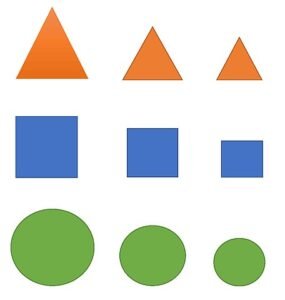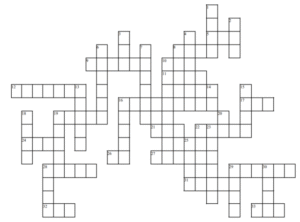9.3 Filling in the Missing Pieces
In addition to the ability to work through the steps of a proof to reach the conclusion, if is often helpful to be able to recognize other missing pieces of an argument: which rule has been applied, what the premises ought to be, or how to translate everything back into English. This module offers suggestions and practice on doing those three things.
Table of Contents
9.3.1 Recognizing Applications of a Rule

Recognizing rules of inference is like learning to recognize any other pattern.
Image Credit: MehreenH, under license CC BY-SA 4.0 (https://creativecommons.org/licenses/by-sa/4.0/) via Wikipedia
Recognizing the Rule
Recognizing which rule has been applied requires a different kind of thinking: instead of following the rules from line to line, it requires figuring how which rule would be needed to justify the move from line to line. The more familiar you are with the rules of inference, the easier it will be to think “backwards” in this way: the less familiar you are with the patterns in the rules of inference, the more challenging this will be. For example, suppose you know that: an argument makes this series of moves:
- ~~~N => L
- ~(B v N)
- ~B & ~N (??)
- ~N (??)
- ~~~N (??)
- L (??)
Which rules did the argument use along the way?
Well, if you remember the patterns in the rules of inference, you will be able to recognize that line 3 came from line 2 through the use of a rule which allows switching between conjunctions and disjunctions with negation, which is DeMorgan’s Law (2 DEM). Line 4 came from a rule that allows taking apart a conjunction from line 3, which is conjunction elimination (3 &E). Line 5 came from a rule allowing the addition of two negatives, which is double negation (5 DN). And line 6 came from lines 1 and 5, through a rule which allows someone to derive the consequent (L) from the antecedent (~~~N) of a conditional (~~~N => L), which is the rule of Modus Ponens (1, 6 MP).
The trick is to first describe in your own mind what was done in abstract terms and then look for a rule which allows that to be done. For instance, don’t say “~B & ~N was written on line 3”, but rather “A conjunction was written on line 3”, and then look at the three rules which allow you to derive a conjunction: DEM, NEGCON, and &I. Of those three rules, only one of them allows you to derive a conjunction of two negations from a negated disjunction, which is DEM. So, DEM must be the rule which was used on line 3.
Practice using the rules of inference, and it will be easier to recognize which ones have been applied.
9.3.2 Complex Enthymemes

Figuring out an enthymeme is like solving part of a crossword puzzle.
Working Backwards
An enthymeme is an incomplete argument, one with a missing premise, where your task is to work backwards to figure out what the premise must have been in order to validly generate the conclusion. Here is an example:
1. ???
2. Some cats are meow.
C. Some animals meow.
What premise would need to be on line one to make the argument valid? Well, begin with what we know about the form of the argument:
1. ??
2. Some M are P
C. Some S are P
Where:
S = animals
P = things that meow
M = cats
Lines 2 and C are both I sentences. So we know the syllogism would be AII, EII, III, or OII. Of those, only the mood AII is valid. So, line 1 must be an A-sentence:
1. All …
Further, we know AII is only valid in Figure 1 (AII-1) and Figure 2 (AII-3). So, the first premise must be either:
1. All M are P
1. All cats are things that meow
or
1. All P are M
1. All things that meow are cats
Either of those premises would make the argument valid, and so either of them would be correct answer to the enthymeme.
The same principles apply when ‘working backwards’ in propositional logic, or when using other rules of inference besides categorical syllogism. In this case, instead of paying attention to mood and figure, pay attention to which rules were applied: For instance:
1. ??
2. Mary lost a tooth.
C. Mary needs dentures.
Here, the correct missing premise depends on the rule used. If AUI was used, then it is:
1. All people who lost a tooth are people who need dentures.
2. Mary lost a tooth.
C. Mary needs dentures (1, 2 UI)
Alternatively, it could have been disjunctive syllogism:
1. Either Mary did not lose a tooth, or Mary needs dentures
2. Mary lost a tooth
3. Mary did not not lose a tooth (2 DN)
C. Mary needs dentures (1, 3 DS)
Or, it could have been modus ponens:
1. If Mary lost a tooth, then Mary needs dentures
2. Mary lost a tooth.
C. Mary needs dentures. (1, 2 MP)
Look to the rule to know what the premise must have been.
Identifying the possible missing premises in an argument which would be needed to make the argument valid is an important skill for being able to extract or compose your own arguments.
9.3.3 Translating Back into English

Pay attention to the scope of negation when translating symbolic logic into English.
Translating Back into English
We’ve already spent a lot of time symbolizing sentences in this class, but we haven’t practiced much going the opposite direction: translating symbolized arguments back into English. The basic idea isn’t that difficult: for any connective, simply fill in the corresponding word in English for that connective, and for any atomic sentence letter, fill in the sentence represented by that letter. For instance, suppose that
P = “The Princess had a birthday party”
Q = “The Queen gave the princess a present”
Then:
| P & Q | The princess had a birthday party and the queen gave the princess a present. |
| P v Q | The princess had a birthday party or the queen gave the princess a present. |
| P => Q | If the princess had a birthday party then the queen gave the princess a present. |
| P ⇔ Q | The princess had a birthday party if and only if the queen gave the princess a present. |
Translating ‘Not’
What makes the process tricky is what to do with the negation sign (~), ‘not’. The rules of English grammar don’t usually permit us to negate a sentence by placing the word ‘not’ at the front:
~P & ~Q
!? Not the princess had a birthday party and not the queen gave the princess a present.
In fact, placing the word ‘not’ or ‘non’ in different locations can change the meaning of the sentence:
~P
!? The non-princess had a birthday party
!? The princess had a non-birthday party
!? The princess had a birthday non-party
None of the sentences above correspond to the logical operator ~, because all of them could be true even while “The princess had a birthday party” is also true. None of these things exclude her from also having a birthday party. Both the princess and the non-princess (some knight, for instance) could have a birthday party; the princess could have both a birthday party and a non-birthday (say, Halloween) party; the princess could have a birthday non-party (like a birthday trip to the dentist) as well as a birthday party. Negation (~) is only true when the negated sentence is false. So, a literal translation of ~P would be:
It is false that the princess had a birthday party
or
It is not the case that the princess had a birthday party
While both of these are literally correct, neither is very natural in English. An accurate but more natural translation of the ~ sign into English involves applying the word ‘not’ (or ‘is not’, or ‘does not’) to the main verb of the sentence instead, adjusting the tense and conjugation of the verb as needed:
~P
The princess did not have a birthday party.
~Q
The queen did not give the princess a present.
Negation in Complex Sentences
Here is a useful chart for translating back into English some more complex sentence types.
| Symbolization | English |
| ~(P v Q) | Neither P nor Q |
| ~(P & Q) | Not both P and Q |
| ~(P => Q) | It is not the case that if P then Q |
| P & ~Q | P but ~Q |
| ~P & Q | ~P but Q |
| P => ~Q | If P then ~Q |
Two things are worth noticing. First, notice that the word ‘but’ usually is more appropriate than the word ‘and’ when one conjunct is negated and the other conjunct is not negated.
Second, notice that it is not appropriate to translate a negate conditional in the following way:
~(P => Q)
!? If the princess had a birthday party then the queen did not give the princess a present. (WRONG!!!)
This is a fallacy of scope, the mistake of taking a negation which applies to the whole conditional ~(P=>Q) for a negation which applies only to the consequent of the conditional (P => ~Q). This is why the phrase, awkward as it is, “It is not the case that…” must be used when negating a whole conditional.
Submodule 9.3 Quiz
Licenses and Attributions
Key Sources:
- Watson, Jeffrey (2019). Introduction to Logic. Licensed under: (CC BY-SA).
Next Page: 9.4 Argumentative Strategies
